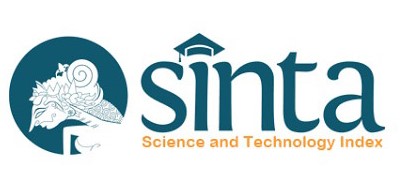Blokade Saraf Femoral-Popliteal pada Pasien dengan Pseudarthrosis Kongenital Tibia yang Menjalani Prosedur Ilizarov Berulang
Abstract
Latar belakang: Penggunaan blokade saraf perifer pada pasien pediatrik semakin meningkat karena dinilai aman, mengurangi kebutuhan opioid, efek samping minimal, pulih sadar lebih cepat dan mengurangi lama hari rawat. Untuk prosedur pembedahan ekstremitas bawah minimal diperlukan dua blokade saraf perifer.
Kasus: Kami laporkan dua kasus pasien pediatrik (4 dan 6 tahun) dengan pseudarthrosis kongenital tibia yang menjalani prosedur Ilizarov berulang. Manajemen anestesi dilakukan dengan kombinasi blokade saraf femoral-popliteal dengan levobupivacain 0,3% dan pasien disedasi dengan propofol 75 mcg/kgBB/menit selama intraoperasi. Kombinasi blokade saraf dilakukan dengan menggunakan stimulasi saraf perifer dengan bantuan pencitraan USG. Parameter yang dinilai ialah kekuatan efek analgetik dari blokade saraf perifer, pemberian analgetik tambahan serta efek samping kombinasi blokade saraf femoral-popliteal. Operasi berlangsung selama 2 jam dengan pemberian analgetik tambahan fentanyl intraoperasi sebanyak satu kali.
Kesimpulan: Kombinasi blokade saraf femoral-popliteal dapat menjadi teknik anestesi pilihan pada kasus pseudarthrosis kongenital tibia. Teknik tersebut memberikan hasil yang memuaskan, mengurangi penggunaan opioid dan tidak ada efek samping. Penambahan fentanyl intraoperatif kemungkinan disebabkan blokade saraf perifer yang tidak adekuat pada osteatom tibia karena penggunaan konsentrasi levobupivacain yang rendah.
Keywords
Full Text:
PDFReferences
Lonsdale H, Owen J. Anaesthesia for paediatric lower limb surgery. BJA Educ. 2016;16(2):58-65. doi:10.1093/bjaceaccp/mkv014
Bosenberg A. Benefits of regional anesthesia in children. Paediatr Anaesth. 2012;22(1):10-18. doi:10.1111/j.1460-9592.2011.03691.x
Flack S, Anderson C. Ultrasound guided lower extremity blocks. Paediatr Anaesth. 2012;22(1):72-80. doi:10.1111/j.1460-9592.2011.03666.x
Muhly WT, Gurnaney HG, Ganesh A. Regional anesthesia for pediatric knee surgery: A review of the indications, procedures, outcomes, safety, and challenges. Local Reg Anesth. 2015;8:85-91. doi:10.2147/LRA.S73458
Li A, Wei Z, Liu Y, et al. Ropivacaine versus levobupivacaine in peripheral nerve block: A PRISMA-compliant meta-analysis of randomized controlled trials. Medicine (Baltimore). 2017;96(14):e6551. doi:10.1097/MD.0000000000006551
Canales MB, Matthew Reiner HH, Mark Razzante DJE. The Popliteal Nerve Block in Foot and Ankle Surgery: an Efficient and Anatomical Technique. J Anesth Clin Res. 2015;06(08):4-10. doi:10.4172/2155-6148.1000553
Fournier R, Faust A, Chassot O, Gamulin Z. Levobupivacaine 0.5% provides longer analgesia after sciatic nerve block using the labat approach than the same dose of ropivacaine in foot and ankle surgery. Anesth Analg. 2010;110(5):1486-1489. doi:10.1213/ANE.0b013e3181d3e80b
Magnussen RA, Pottkotter K, Stasi S Di, et al. Femoral Nerve Block after Anterior Cruciate Ligament Reconstruction. J Knee Surg. 2017;30(4):323-328. doi:10.1055/s-0036-1584538
Malav K, Singariya G, Mohammed S, Kamal M, Sangwan P, Paliwal B. Comparison of 0.5% ropivacaine and 0.5% levobupivacaine for sciatic nerve block using labat approach in foot and ankle surgery. Turk Anesteziyoloji ve Reanimasyon Dern Derg. 2018;46(1):15-20. doi:10.5152/TJAR.2017.03411
Provenzano DA, Viscusi ER, Adams SB, Kerner MB, Torjman MC, Abidi NA. Safety and efficacy of the popliteal fossa nerve block when utilized for foot and ankle surgery. Foot Ankle Int. 2002;23(5):394-399. doi:10.1177/107110070202300504
Kang RA, Shin YH, Gil NS, Kim KY, Yeo H, Jeong JS. A comparison of the use of propofol alone and propofol with midazolam for pediatric magnetic resonance imaging sedation - a retrospective cohort study. BMC Anesthesiol. 2017;17(1):1-5. doi:10.1186/s12871-017-0431-2
Lam DKM, Corry GN, Tsui BCH. Evidence for the use of ultrasound imaging in pediatric regional anesthesia: A systematic review. Reg Anesth Pain Med. 2016;41(2):229-241. doi:10.1097/AAP.0000000000000208
Astuto M, Privitera C, Gurrieri C, et al. Sciatic Nerve Block in the Popliteal Fossa Using Lateral Approach in an Infant with Goldenhar Syndrome. Open Anesthesiol J. 2013;7(1):12-14. doi:10.2174/1874321801307010012
Oberndorfer U, Marhofer P, Bösenberg A, et al. Ultrasonographic guidance for sciatic and femoral nerve blocks in children. Br J Anaesth. 2007;98(6):797-801. doi:10.1093/bja/aem092
Jeon HJ, Park YC, Lee JN, Bae JS. Popliteal sciatic nerve block versus spinal anesthesia in hallux valgus surgery. Korean J Anesthesiol. 2013;64(4):321-326. doi:10.4097/kjae.2013.64.4.321
Schloss B, Bhalla T, Klingele K, Phillips D, Prestwich B, Tobias JD. A retrospective review of femoral nerve block for postoperative analgesia after knee surgery in the pediatric population. J Pediatr Orthop. 2014;34(4):459-461. doi:10.1097/BPO.0000000000000113
Montes FR, Zarate E, Grueso R, et al. Comparison of spinal anesthesia with combined sciatic-femoral nerve block for outpatient knee arthroscopy. J Clin Anesth. 2008;20(6):415-420. doi:10.1016/j.jclinane.2008.04.003
DOI: http://dx.doi.org/10.21776/ub.jap.2020.001.03.06
Refbacks
- There are currently no refbacks.

This work is licensed under a Creative Commons Attribution 4.0 International License.









.png)

